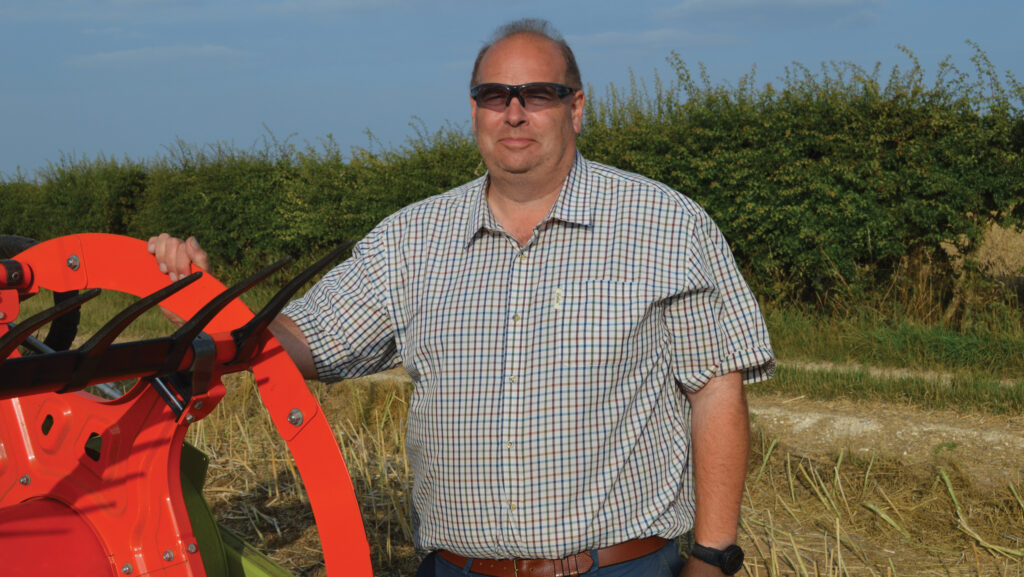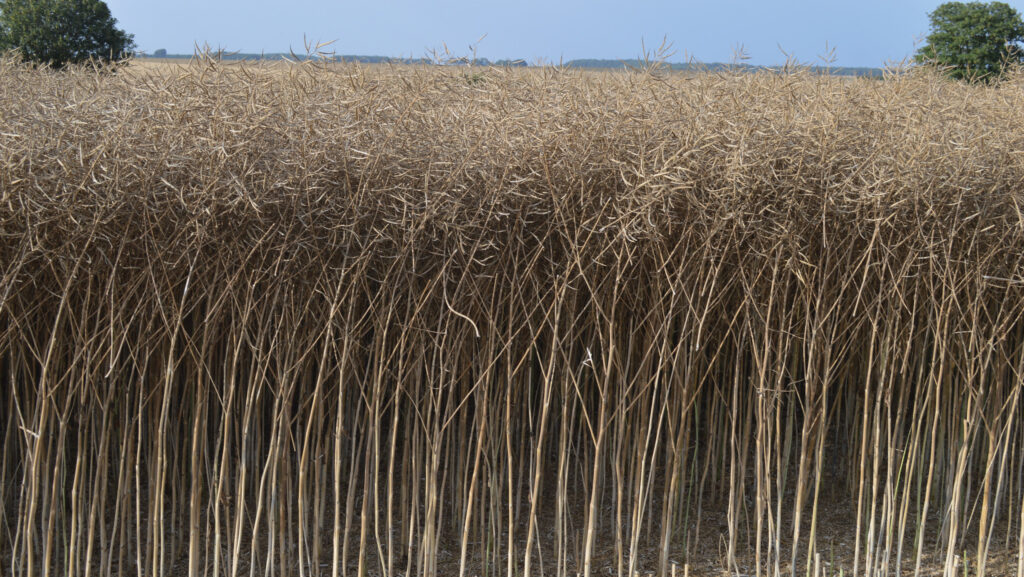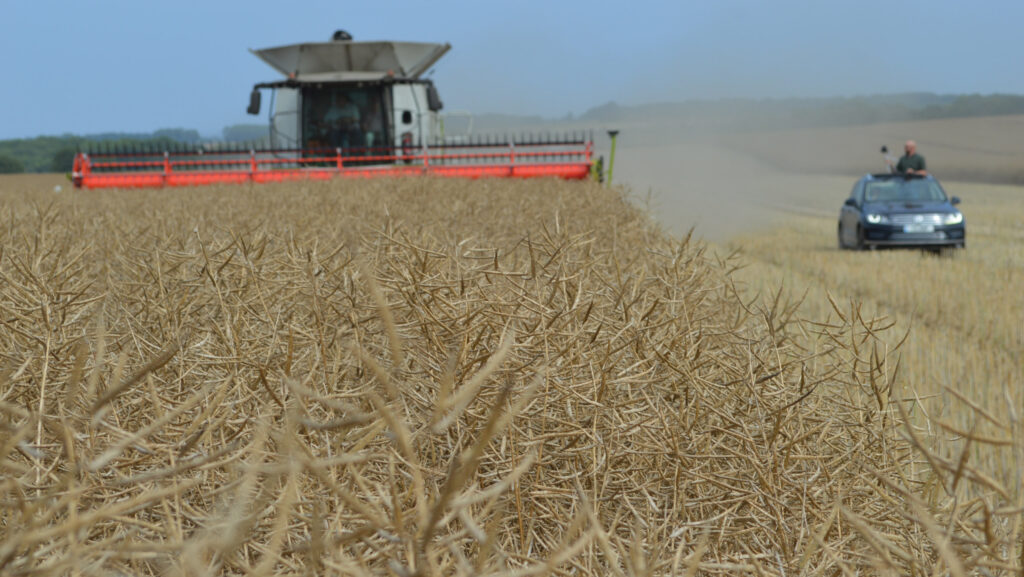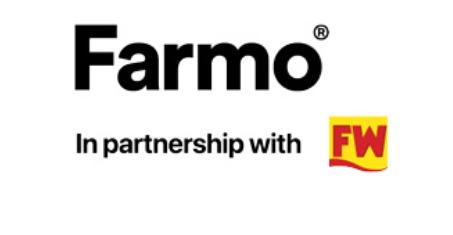Farmer sets OSR world record in the Lincolnshire Wolds
 © David Jones
© David Jones Tim Lamyman is doing what he does best – setting new world records. This time it is a record-yielding oilseed rape crop of 7.52t/ha helped by late drilling and an early foliar feed.
The new world record is nearly three times the UK national 2024 average yield. It was produced from a crop over 2m in height, with an unbroken thick canopy on the Lincolnshire Wolds.
Delaying drilling well into September helped avoid cabbage stem flea beetle damage, while an early growth-stimulating liquid feed produced “stunning growth” in the early autumn to set the crop up for a bumper harvest.
See also: 4 ways to solve common soil issues on arable farms

Tim Lamyman © David Jones
“Later drilled oilseed rape needs to be the new fashion to minimise the damage from flea beetles,” says Tim.
The season has appeared to favour the crop, as it thrived in the drier conditions seen this spring and summer, and coped with the effects of climate change better than other crops.
Input levels
Input levels for the record crop were not outlandishly excessive with 200kg/ha of nitrogen applied, three autumn herbicides and two flowering fungicide sprays.
Total variable costs amounted to £580/ha for a crop worth more than £3,000/ha.
Within those variable costs, his six-spray foliar feed programme cost £145/ha, which at current prices equates to about 0.3t of rapeseed.
A new hybrid variety with claimed resilience to flea beetles from plant breeder Limagrain and the tweaking of his foliar feed programme from manufacturer Bionature helped grow this high-yielding crop.
The 7.52t/ha yield was across the 8ha minimum needed to claim a world record.
It beat the unofficial record of 7.19t/ha across a smaller area, achieved in harvest 2019 by Richard Budd in Kent, and was way above the UK 2024 average yield of 2.8t/ha.
The rapeseed record is now added to Tim’s other world records for winter wheat at 17.96t/ha and winter barley at 16.21t/ha, both achieved at harvest 2022.
The programme of foliar feeds from Bionature consisted of six sprays – three in the autumn and three in the spring – and five of the six were incorporated into existing spray timings with only the first applied on its own.
OSR rethink
Tim has produced some very high-yielding crops of oilseed rape on his 600ha arable farm at Worlaby, five miles south of Louth, but problems with flea beetles in autumn 2023 prompted a rethink.
Then, his oilseed rape was drilling in the third and fourth weeks of August only to be wiped out by flea beetles, but two fields were re-drilled on 12 and 14 September, and went on to yield an impressive 4.5t/ha at harvest 2024.
“After that experience, we wished we had re-drilled the whole oilseed rape area at that time,” he says.
This prompted him to set the date of 10 September to start drilling OSR at Worlaby, reinforced by the knowledge that he had never lost a crop in the past nine years that had been drilled after 5 September.
The OSR crop is important as it is the only break crop grown on the farm which grows mainly winter wheat with some winter barley and spring barley.
Fortunately, this season has seen relatively low levels of flea beetles.
Variety
The variety chosen in autumn 2024 for the record-attempting crop was the hybrid Avenger.
It was new to the AHDB Recommended List for the northern region, claimed to have flea beetle resilience and was the tallest variety on the list.
Tim says Avenger played a key part in the crop’s success as it showed incredible autumn vigour and good spring growth.
It fitted his requirement for a variety with high biomass and was suitable for later drilling.
The seed rate for the variety was a little on the high side for a hybrid at 4kg/ha, but Tim wanted to ensure there was a well-established crop drilled late on the top of the Wolds, so he applied a pre-emergence herbicide.
The field chosen was nearly 400ft above sea level of free-draining chalky loam soil, which in the past had seen high-yielding wheat crops.

© David Jones
Nutrition
This season, Tim did not use di-ammonium phosphate (DAP) fertiliser in the OSR seed-bed as his experience had shown that oilseed rape did not have the chance to utilise the fertiliser before being attacked by flea beetles.
Instead, he moved to a slightly cheaper strategy of using a mixture of foliar feeds at the two to four cotyledon leaf stage, or some two weeks after the 10 September drilling date.
The mix was Bionature’s Leodita with HNK Delta.
The former contains humic and fulvic acids, as well as trace elements and is described as a soil enhancement product.
It is said to improve soil structure, help the release of manganese and phosphate from the soil and increase soil bacterial activity.
The second Delta is a nitrogen and potassium foliar fertiliser to enhance root growth.
The effect was dramatic and immediate in the autumn with strong growth seen compared to other rapeseed on the farm without the treatment.
After this, a post-emergence herbicide was applied along with a fungicide for light leaf spot and an insecticide.
Into this mixture went macronutrient and micronutrient product TipTop and also Delta. This was followed later in the autumn by another herbicide with Delta added.
Spring inputs
Through to the spring, a relatively modest 200kg/ha of ammonium nitrate was applied in a three-way split, as Tim say he has no evidence the crop needs more.
He relies on the fungicide tebuconazole used in the spring to give him some plant growth regulatory effect.
A stem extension spray of Leodita/Delta plus fungicides was applied, and then two fungicide flowering sprays, which also contained TipTop, nutrient mix XStress and calcium mix Calflux.
A glyphosate spray to desiccate the crop was applied 17 days before the harvest date of 25 July. No pod stick products were used.
The thick crop was cut by Tim’s Claas Lexion 770 with a 9m header.
The 8ha dense crop took nearly four hours to cut with the combine reel set at its highest to deal with the 2m-plus high crop, although the combine still suffered occasional near blockages in fertile lower lying parts of the field.
The combine registered yields between 6.5 and 8.5t/ha.
“I am thrilled to get the world record, and I am over the moon with Bionature, Limagrain and United Oilseeds for their help,” he says.
Bionature provided the foliar feeds, Limagrain the variety and United Oilseeds has encouraged a revival in the area of OSR grown.
For next season, the same treatments will be spread across all his 85ha of OSR, and the season will probably be a sterner test for flea beetles after such a hot summer.
The world record attempt was overseen by independent adjudicators ex-Adas mechanisation expert Bill Basford and Gordon Cummings from supply group Fram Farmers.

© David Jones
World-record yielding oilseed rape crop |
|
|
Previous crop |
Winter barley, straw baled |
| Cultivations |
Vaderstad TopDown disc and tine cultivator down to 15cm to get air into the soil, and then Vaderstad Carrier disc cultivator to 5-6cm |
|
Drilled |
10 September with 6m Vaderstad Rapid |
| Variety |
Avenger, seed rate 4kg/ha |
| Pre-emergence herbicide |
Banastar (dimethenamid-P + metazachlor + quinmerac) |
| Early foliar feed |
Leodita + NHK Delta |
| Post-emergence treatment |
Herbicide Centurion Max (clethodim) + fungicide prothioconazole + insecticide Hallmark (lambda-cyhalothrin) + TipTop and Delta |
| Late autumn | Herbicide Kerb (propyzamide) + Delta |
| Spring nitrogen | Three-way split of 200kg/ha of ammonium nitrate |
| Spring stem extension |
Fungicides prothioconazole and tebuconazole + Leodita and Delta |
| Early flowering |
Fungicide Skyway (bixafen + prothioconazole + tebuconazole) + TipTop/Xstress/Calflux |
| Late flowering |
Fungicide Amistar (azoxystrobin) + TipTop/XStress/Calflux |
| Glyphosate |
17 days before harvest |
| Harvest |
25 July – moisture content 6.3-7.6% |
| Yield |
7.52t/ha standardised to 9% moisture and 40% oil |

